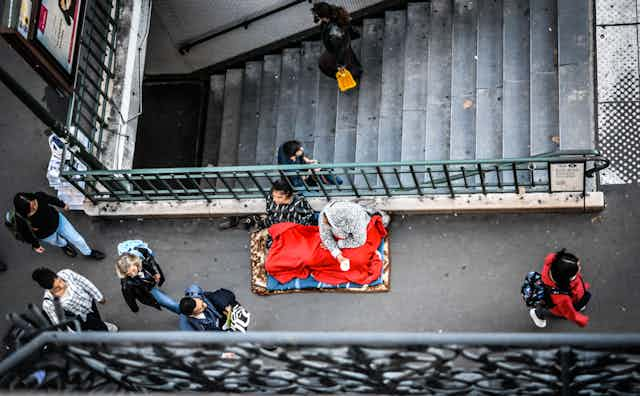When I first met Daniel* in front of Shoreditch High Street station in London, I didn’t know how exhausting begging was. He was constantly moving, often through cold and rain. He addressed random passers-by all day long, mostly facing ignorance from their side if not verbal and physical aggression. He told me:
Many people think, that if they give, that keeps me on the street – but it really makes life bearable. It’s not all about money … What I appreciate is respect. Respect and understanding make me feel like a human being.
Daniel was hustling to survive – in search of resources, like money and food, but also respect. Begging is a means to this end and hard labour in every sense of the word, both physical and emotional. It isn’t just a passive activity of passing the time to get through the day but an active form of engagement that is often reflected on and thought through. As a long-term unemployed homeless person, it was one of the only ways for Daniel to survive.
This kind of activity – and others such as finding and making shelter – are forms of labour and work that are worth taking seriously, both in order to support people like Daniel on an immediate, personal level, and ultimately to adapt government policies accordingly.
An active process
Homelessness is exploding across the West. Rough sleeping in the UK alone has risen by almost 170% since 2010. Altogether, one in 200 people is homeless in the UK. Similarly, in France, according to official government statistics, the number of homeless people rose by 50% between 2001 and 2011.
Based on six years of work on homelessness in London and Paris, most recently two years of full-time fieldwork in the French capital, my research has tried to generate a bottom-up understanding of how homeless people survive and make a living. My research has shown me that most homeless people are not passively suffering but that they often actively try to make their lives better. Two examples of men – Pascal* and Carl* – help to demonstrate this.
Pascal, a Congolese man in his early 20s. I met him in Paris in summer 2015, and found he had a well thought-through daily work routine to earn money through begging. In the mornings, he was trying to catch the commuters coming into the Gare de l'Est. At lunchtime, he stood in front of a specific, busy boulangerie in the ninth arrondisement, a rather well-off residential area of the city. In the afternoon, he was at Gare de l’Est waiting for the trains bringing German tourists he could easily relate to in a language he speaks.
Pascal had developed these different spots where he could approach different groups – lunchgoers he would see several times a week, random but compassionate tourists, people that likely speak his language – with different tactics. For every group, Pascal also had a specific way of addressing them, a specific spiel touching on different points: he needed money for the train, or wanted to buy food, or to get himself a night in a shelter. He knew from experience that different groups are more likely to give when they hear a certain narrative.
Pascal was the norm rather than the exception of the homeless people I engaged with on the streets around the city’s train stations. For him and the others, begging was not just sitting around, but an active process of labour, often a first step to order and routine.
Seeking shelter
Homeless people also don’t blindly rely on social services for housing, a process that can take from months to years. Many of them actively choose spots, collect material and symbolically construct shelters for themselves within the cities they live in. Carl, a young German I met early in 2015 in Paris, was one of them.
“They call me the train man – even though I don’t even sleep there anymore. But I found it,” Carl explained to me with pride when I asked him about his shelter. He took me to see the train he was talking about, close to the metro stop Créteil in the south of Paris. It was an old inter-city train waiting to be moved to where it would eventually be recycled.
This used to be my job – intelligence, finding things – and finding this train was easy. I just used Google maps, and a day later I started sleeping here … I just ripped out the old curtains and used them as a blanket. The compartments are perfect, a little home.
The fact that the trains were easy to reach, less than 30 minutes from the Gare du Nord, and were available for stable intervals of time, made them the perfect mid-term shelters for people like Carl. Many others followed Carl to the train in the months after his discovery.

A different group of people I spoke to slept in a spacious parking lot under the banking district. Others preferred the security of a public place surveyed by the police such as the area directly around train stations. Most of them would come equipped with cardboard, blankets, duvets or plastic bags to keep their laundry and other utensils. All of them were actively trying to make a home on the street while being homeless.
Daniel, Pascal and Carl are only three of the many people I have observed over my years of working with people on the street. Many are struggling to survive within both physical and institutional structures which in many cases try to support them, but in many others keep them on the street.
Understanding the efforts these people go to to make their lives better will help institutions such as homeless charities, NGOs and government agencies to support them by building on their own efforts – rather than imposing new and at times alien initiatives on them.
*All names have been anonymised to protect the identity of interviewees.


